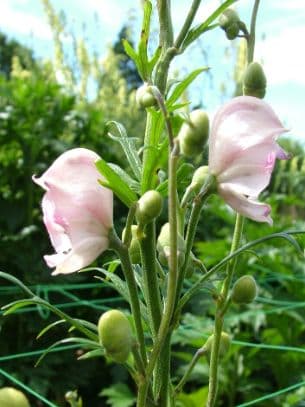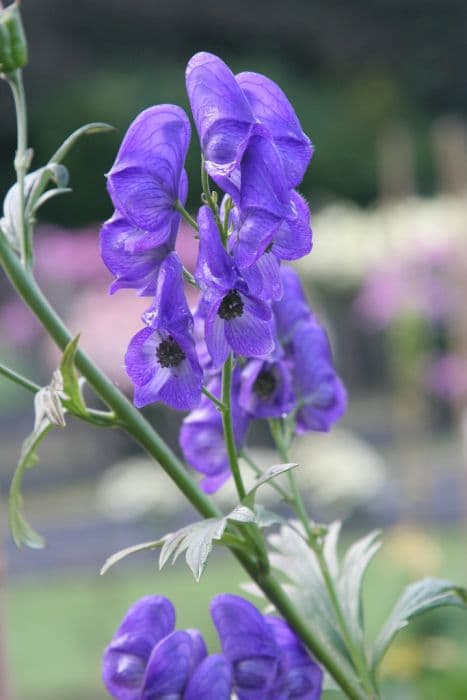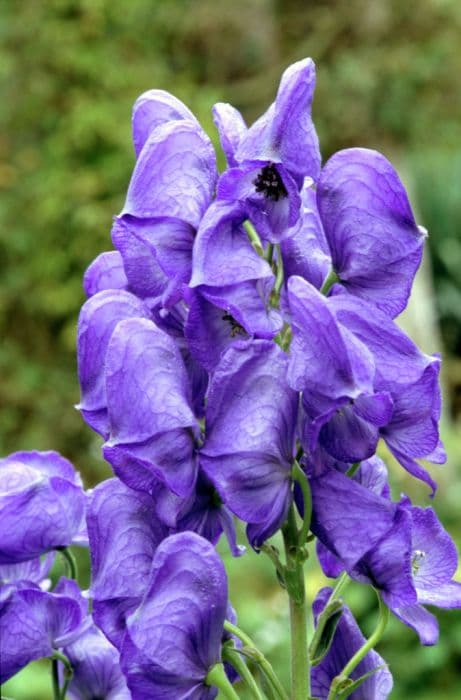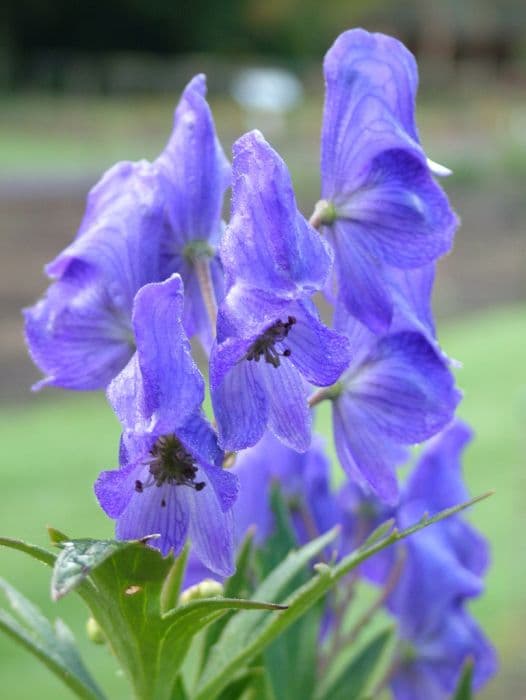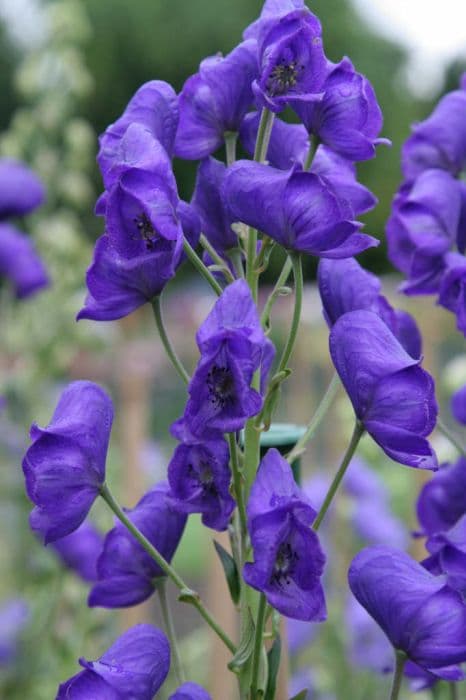Summer Skies Delphinium Delphinium Summer Skies Group

ABOUT
Delphinium Summer Skies Group is a strikingly beautiful flowering plant known for its showy spires of blooms that exhibit a magnificent blend of sky blue to pale blue shades. These flowers have a subtle ombre effect, transitioning in hues as they ascend the elongated flower stalks. The blooms are populated with multiple semi-double to fully double florets, each petal delicately frilled at the edges, providing a soft, almost ruffled texture. In the center of each bloom, there are tiny, white or light-colored bees, which are small central petals that add a contrasting eye to the flowers. The foliage of Delphinium Summer Skies is also attractive; it comprises numerous deeply lobed, green leaves that create a lush backdrop for the majestic flower spires. The plant, in its entirety, is a robust and upright perennial that adds vertical interest and a cottage garden feel to any landscape. Its blooms are highly sought after for their traditional charm and are often used in cut flower arrangements for their lasting beauty and height.
About this plant
 Names
NamesFamily
Ranunculaceae
Synonyms
Larkspur, Candle Delphinium
Common names
Delphinium Summer Skies Group
 Toxicity
ToxicityTo humans
The plant commonly known as larkspur is toxic to humans. All parts of the plant contain alkaloids that can lead to poisoning if ingested. Symptoms of larkspur poisoning can include nausea, vomiting, abdominal pain, and muscle weakness. In severe cases, it can cause respiratory difficulty and heart rhythm abnormalities which can be potentially life-threatening.
To pets
Larkspur is also toxic to pets, including cats and dogs. If a pet ingests any part of the larkspur plant, it can experience similar symptoms as humans, such as drooling, abdominal pain, vomiting, and diarrhea. Other signs of toxicity in pets can include muscle tremors, stiffness, weakness, seizures, difficulty breathing, and cardiac failure. Severe poisoning can be fatal, so immediate veterinary attention is required.
 Characteristics
CharacteristicsLife cycle
Perennials
Foliage type
Deciduous
Color of leaves
Green
Flower color
Blue
Height
4-6 feet (1.2-1.8 meters)
Spread
1-2 feet (0.3-0.6 meters)
Plant type
Herb
Hardiness zones
3-7
Native area
Europe
Benefits
 General Benefits
General Benefits- Ornamental Value: Delphinium Summer Skies adds aesthetic appeal to gardens with its tall spikes of sky-blue flowers, making it a stunning backdrop for border plantings.
- Attracts Pollinators: The blooms are attractive to bees, butterflies, and other pollinating insects, which are beneficial for the garden ecosystem.
- Versatility in Landscaping: It can be used in a variety of garden designs, including cottage gardens, formal borders, and mixed perennial beds.
- Seasonal Color: It provides vibrant color during the summer months when many other plants may not be in peak bloom.
- Height Variation: Offers vertical interest in the garden, which can be useful for creating layers and depth in garden design.
- Cut Flowers: The stems are long-lasting when cut, making them ideal for bouquets and floral arrangements.
 Medical Properties
Medical PropertiesThis plant is not used for medical purposes.
 Air-purifying Qualities
Air-purifying QualitiesThis plant is not specifically known for air purifying qualities.
 Other Uses
Other Uses- Delphiniums can be used as a natural fabric dye, imparting shades of blue to textiles, depending on the mordant used.
- These flowers are often used in educational settings for plant biology studies due to their distinct and prominent flower structure.
- Delphinium petals can be used in the art of pressed flowers, which are then used for crafting decorative bookmarks, greeting cards, and other paper-based items.
- Some gardeners use the tall stalks of delphiniums as natural supports for other plants in the garden, such as climbing vines that need a structure to grow on.
- The plant can be used as a focal point in intricate garden designs, such as knot gardens and parterres, due to its height and striking flowers.
- Delphiniums can be a source of inspiration for artists and photographers, who capture the intricate details and vibrant colors of its blooms.
- The strong stems of delphiniums are sometimes incorporated into handmade wreaths and other floral arrangements for added stability and height.
- Dried delphinium flowers can be used in potpourris, often for their aesthetic appeal rather than their scent because they do not retain fragrance well when dried.
- They can be employed in sensory gardens, where their bright colors and large blossoms can be appreciated up close, especially by those with visual impairments.
- Delphiniums can be grown in containers on patios or balconies to create a vibrant display of height and color in small spaces.
Interesting Facts
 Feng Shui
Feng ShuiThe Delphinium is not used in Feng Shui practice.
 Zodiac Sign Compitability
Zodiac Sign CompitabilityThe Delphinium is not used in astrology practice.
 Plant Symbolism
Plant Symbolism- Protection - Delphiniums are often associated with protection due to their tall, sheltering presence in a garden and historical use in warding off dangers.
- Openness to New Experiences - The expansive reach of delphinium petals symbolizes an embrace of the possibilities that lie ahead and the open-mindedness required to pursue them.
- Fun - The bright, cheerful blooms of the Summer Skies variety evoke a sense of light-heartedness, joy, and the spirit of fun.
- Positivity - Delphiniums, especially in such a sky-like blue shade, represent positivity and the encouragement to maintain a positive outlook on life.
- Lightness and Levity - The delicate structure of the flowers suggests a sense of lightness and encourages an attitude of levity.
- Arbitrary Affection - In the language of flowers, delphiniums can signify a capricious, whimsical type of affection that is (perhaps unexpectedly) strong and deep.
 Water
WaterLarkspur, commonly known as Delphinium, requires consistent moisture, especially during the growing season. It is best to water deeply once or twice a week, providing about one to one and a half gallons per plant, depending on weather conditions. Make sure the water penetrates the soil to reach the roots rather than just wetting the surface. Frequent shallow watering should be avoided because it may promote root diseases and does not establish a deep root system. During hot, dry spells, you may need to water larkspurs more frequently to maintain the soil moisture; but reduce watering as the weather cools and rainfall increases.
 Light
LightLarkspur thrives in a location that receives full sun for at least 6 to 8 hours per day. These plants prefer a setting where they get ample morning light, which helps their blooms to open fully. An ideal spot is one where they are protected from intense afternoon sun in particularly hot climates, as this can cause stress on the plant.
 Temperature
TemperatureLarkspur can tolerate mild frosts, but the best range for growing is between 50°F to 75°F. They can survive minimum temperatures down to about 40°F and maximum temperatures up to around 85°F, although extended periods of heat can be stressful. Ensuring good air circulation around the plants can help mitigate temperature stress.
 Pruning
PruningPrune larkspurs immediately after the first flowering to encourage a second bloom. Deadhead spent flowers regularly to maintain plant vigor and appearance. In late fall or early spring, remove any dead or damaged stalks to prepare the plant for new growth, and cut back to ground level after the first hard frost in autumn for winter dormancy.
 Cleaning
CleaningAs needed
 Soil
SoilLarkspur thrives in rich, well-draining soil with a pH of 6.5 to 7.5. A good mix might include equal parts of loamy garden soil, compost, and peat or sand to ensure proper drainage.
 Repotting
RepottingLarkspurs, being perennial, do not typically require repotting. They prefer being undisturbed and can be left in the same spot for several years.
 Humidity & Misting
Humidity & MistingLarkspurs prefer moderate humidity conditions and can tolerate the average humidity levels found in outdoor environments.
 Suitable locations
Suitable locationsIndoor
Ensure full sun, cool temperatures, and proper staking for larkspurs indoors.
Outdoor
Plant in full sun, with moist, well-drained soil and some wind protection.
Hardiness zone
3-7 USDA
 Life cycle
Life cycleThe Summer Skies Delphinium, typically known as Larkspur, begins its lifecycle with the germination of seeds in early spring, often in a cold frame or indoor setting for early starts. Seedlings grow into young plants with lobed leaves and tall, sturdy stems. During late spring to early summer, the plant enters its flowering stage, showcasing tall spires of sky-blue flowers with a hint of purple and white centers. After pollination by bees, butterflies, or hummingbirds, the flowers develop into follicles containing tiny black seeds by late summer. As an herbaceous perennial, the foliage of the Summer Skies Delphinium dies back to the ground in autumn after the growing season, with the root system remaining dormant through winter. The plant resumes growth the following spring, repeating its cycle, living for several years under optimum conditions.
 Propogation
PropogationPropogation time
Spring to Summer
Propogation: The Delphinium Summer Skies, often known as Larkspur, is commonly propagated through seed sowing. To propagate Larkspur by seeds, the best time is in spring after the last frost when the soil temperature reaches approximately 60-68 degrees Fahrenheit (15-20 degrees Celsius). The seeds should be sown directly into the garden bed in a sunny location with well-drained soil. Cover the seeds with a thin layer of soil, as they require darkness for germination, and keep the soil consistently moist. Germination typically occurs within 2 to 3 weeks. Care should be taken to avoid high humidity levels as this can lead to fungal diseases, which are detrimental to seedlings. Once the seedlings have grown sufficiently and all risk of frost has passed, they can be thinned out or transplanted to their final growing positions, ensuring adequate space for mature growth.

